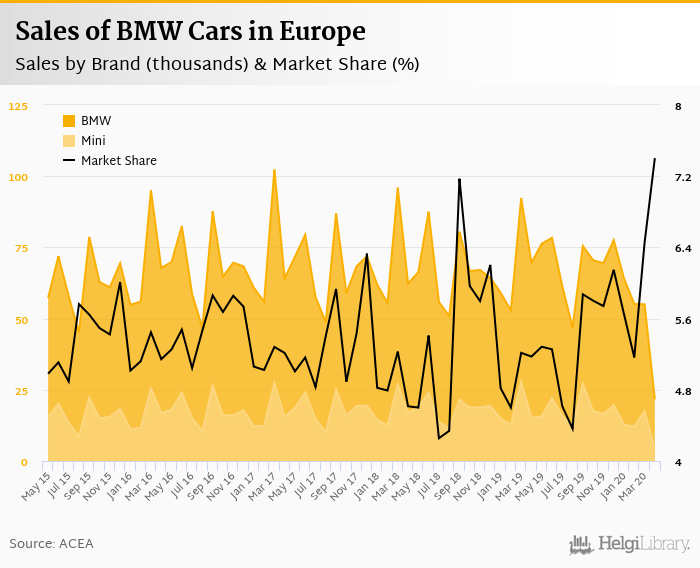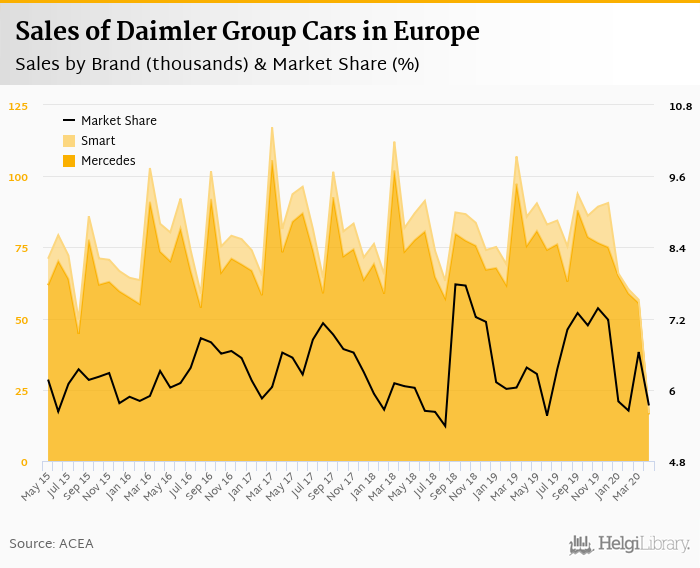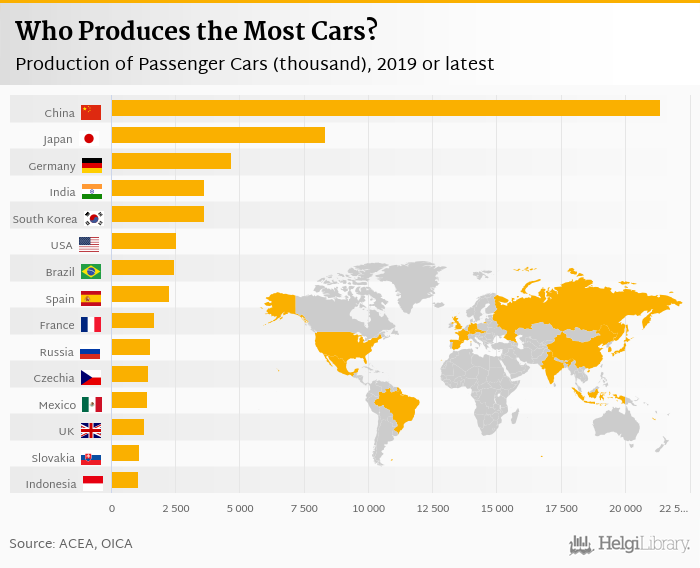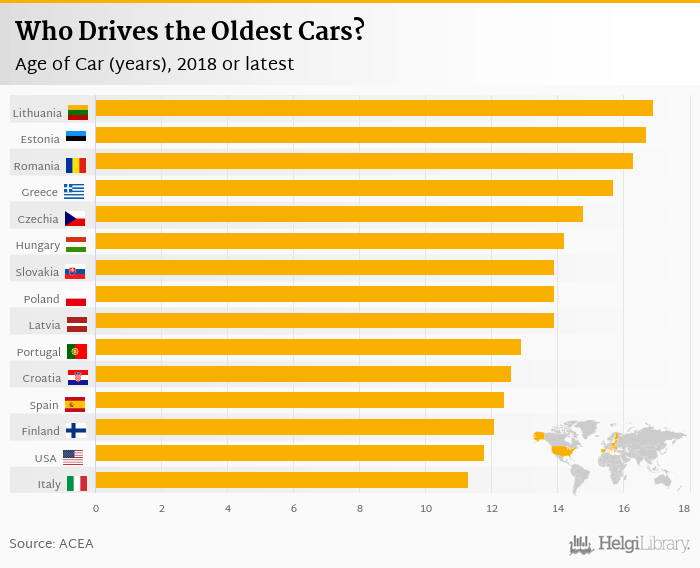Sales of new cars decreased by 1,053 thousand in April compared to last year
In the first four months of the year, the decline reached 39% yoy
Norway performed relatively the best (-34.0%) while sales in Italy showed the weakest change compared to the last year (-97.5%)
Sales of new passenger cars reached 292 thousand in April 2020 in the enlarged Europe (EU plus Iceland, Norway and Switzerland), according to ACEA. This is 78.3%, or 1,053 thousand less than in the previous year. In the first four months of 2020, some 3,347 thousand cars were sold in Europe, down 39.0% yoy.
Historically, between 1990 and 2020, sales of passenger cars in Europe reached a high of 1,937 thousand in March 2017 and a low of 292 thousand in April 2020.


In April, most vehicles (121 thousand) were sold in Germany (down 61.1% yoy), followed by France (21.0 thousand, down 88.8%), Sweden with 18.9 thousand cars (down 37.5%), 15.4 thousand new vehicles were registered in Netherlands (down 53.6%) and 15.2 thousand in Poland (down 67.1%). The five largest countries accounted for 60.3% of total new vehicles registered in April 2020.
In absolute terms, the best performance in sales of new cars has been seen in Iceland (down 0.829 thousand cars) and Latvia (down -0.961 thousand cars). At the other end of the scale, Germany and Italy showed the biggest drop in registration of new cars in April when compared to last year (down 190 thousand and down 170 thousand cars, respectively).
In relative terms, sales in Norway (-34.0%) and Denmark (-37.0%) declined the least compared to a year ago, whereas registration in Italy and the United Kingdom dropped the most (-97.5% and -97.3% yoy), in April 2020, according to ACEA:


In the first four months of the year, some 3,347 thousand cars were sold in Europe, down 39.0% yoy. The table below shows details of the sales for each of the European country:
| Country | April 2020 | April 2019 | YOY Change % | 1-4/2020 | 1-4/2019 | YOY Change % |
|---|---|---|---|---|---|---|
| Austria | 11.2 | 32.0 | -64.9 | 65.9 | 113 | -41.6 |
| Belgium | 5.30 | 53.5 | -90.1 | 133 | 209 | -36.6 |
| Bulgaria | 0.824 | 3.01 | -72.6 | 6.77 | 11.4 | -40.8 |
| Croatia | 1.08 | 8.65 | -87.5 | 11.1 | 20.8 | -46.8 |
| Cyprus | 0.234 | 1.48 | -84.1 | 3.18 | 4.28 | -25.7 |
| Czech Republic | 10.7 | 22.9 | -53.4 | 60.9 | 82.5 | -26.2 |
| Denmark | 10.2 | 16.2 | -37.0 | 59.1 | 82.5 | -28.4 |
| Estonia | 0.824 | 2.53 | -67.5 | 6.47 | 8.71 | -25.7 |
| Finland | 5.98 | 9.75 | -38.6 | 34.2 | 38.8 | -11.8 |
| France | 21.0 | 188 | -88.8 | 386 | 742 | -48.0 |
| Germany | 121 | 311 | -61.1 | 822 | 1,191 | -31.0 |
| Greece | 2.43 | 12.3 | -80.2 | 23.8 | 38.6 | -38.3 |
| Hungary | 6.17 | 12.4 | -50.3 | 38.8 | 46.7 | -16.9 |
| Iceland | 0.372 | 1.20 | -69.0 | 2.85 | 3.92 | -27.3 |
| Ireland | 0.344 | 8.91 | -96.1 | 51.6 | 73.1 | -29.4 |
| Italy | 4.28 | 174 | -97.5 | 351 | 711 | -50.6 |
| Latvia | 0.683 | 1.64 | -58.5 | 4.55 | 6.11 | -25.4 |
| Lithuania | 1.38 | 4.45 | -69.0 | 12.1 | 14.7 | -17.6 |
| Luxembourg | 1.19 | 5.64 | -78.9 | 13.1 | 20.5 | -36.1 |
| Netherlands | 15.4 | 33.1 | -53.6 | 119 | 150 | -20.6 |
| Norway | 7.43 | 11.3 | -34.0 | 39.8 | 49.7 | -20.0 |
| Poland | 15.2 | 46.4 | -67.1 | 123 | 186 | -34.0 |
| Portugal | 2.75 | 21.1 | -87.0 | 48.0 | 80.6 | -40.4 |
| Romania | 4.32 | 8.69 | -50.3 | 32.3 | 44.5 | -27.5 |
| Slovakia | 3.42 | 8.89 | -61.5 | 22.4 | 25.7 | -12.9 |
| Slovenia | 1.85 | 6.16 | -70.1 | 16.2 | 25.9 | -37.5 |
| Spain | 4.16 | 119 | -96.5 | 223 | 436 | -48.9 |
| Sweden | 18.9 | 30.3 | -37.5 | 85.1 | 104 | -18.3 |
| Switzerland | 9.38 | 28.6 | -67.2 | 64.8 | 101 | -35.6 |
| United Kingdom | 4.32 | 161 | -97.3 | 488 | 862 | -43.4 |
| EU + EFTA | 292 | 1,345 | -78.3 | 3,347 | 5,491 | -39.0 |
Volkswagen Group sold the most cars in April 2020 in Europe, some 84.4 thousand vehicles representing 28.9% of the European market. Sales of PSA Group amounted to 38.5 thousand vehicles (or 13.2% of the market) while Renault Group and BMW Group held 9.80% and 8.80% of the European market in April. Overall, the five largest manufacturers sold 67.1% of all new cars in April:
Volkswagen Group sold 84.4 thousand new passenger cars representing a 28.9% share of all new passenger cars sold in Europe in April 2020. This is 74.1% fewer vehicles and a 4.64 pp increase in market share when compared to last year. Looking back three years, VW's market share was 24.3%.
The Group sold 36.5 thousand of Volkswagen brand cars in April, followed by 21.5 thousand of Skodas and 15.3 thousand of Audis. Seat sold 8.51 thousand vehicles and Porsche some 2.41 thousand cars in April 2020:


PSA Group sold 38.5 thousand new passenger cars representing a 13.2% share of all new passenger cars sold in Europe in April 2020. This is 82.4% fewer vehicles and a 3.11 pp decrease in market share when compared to last year. By comparison, the market share three years ago stood at 16.1% and is down by 2.97 pp now.
The Group sold 15.1 thousand of Peugeots cars, followed by 12.0 thousand of Opels and 10.4 thousand of Citroens in April 2020:


BMW Group sold 25.7 thousand new passenger cars representing a 8.81% share of all new passenger cars sold in Europe in April 2020. This is 69.6% fewer vehicles but a 2.50 pp increase in market share when compared to last year. Compared to three years ago, BMW Group's market share is now 2.33 pp higher.
The group sold 21.6 thousand of BMW brand cars, followed by 4.10 thousand of Minis in April 2020:


Hyundai Group sold 18.8 thousand new passenger cars representing a 6.44% share of all new passenger cars sold in Europe in April 2020. This is 79.3% fewer vehicles and a 0.319 pp decrease in market share when compared to last year. Compared to three years ago, Hyundai Group's market share is now 0.144 pp higher.
The group sold 9.68 thousand of Kia brand cars, followed by 9.13 thousand of Hyundais in April 2020:


Renault Group sold 28.6 thousand new passenger cars representing a 9.80% share of all new passenger cars sold in Europe in April 2020. This is 79.5% fewer vehicles and a 0.570 pp decrease in market share when compared to last year. By comparison, three years ago, Renault Group's market share was 10.5%.
The group sold 18.5 thousand of Renault brand cars in April, followed by 10.0 thousand of Dacias and 0.110 of Ladas:


FCA Group sold 11.0 thousand new passenger cars representing a 3.75% share of all new passenger cars sold in Europe in April 2020. This is 87.7% fewer vehicles and a 2.88 pp decrease in market share when compared to last year. By comparison, three years ago FCA Group's market share stood at 7.30%.
The group sold 8.53 thousand of Fiat brand cars in April, followed by 1.58 thousand of Jeeps and 0.661 thousand of Alfa-Romeos:


Toyota Group sold 11.1 thousand new passenger cars representing a 3.81% share of all new passenger cars sold in Europe in April 2020. This is 83.0% fewer vehicles and a 1.05 pp decrease in market share when compared to last year. Toyota Group's market share three years ago, by comparison, stood at 4.36%.
The group sold 10.7 thousand of Toyota brand cars in April, with Lexus following at 0.389 thousand cars:


Jaguar Land Rover Group sold 1.85 thousand new passenger cars representing a 0.634% share of all new passenger cars sold in Europe in April 2020. This is 90.3% fewer vehicles and a 0.782 pp decrease in market share when compared to last year. Three years ago however, the market share of Jaguar Land Rover Group was 1.35%.
The group sold 0.999 of Land Rovers in April, followed by 0.853 thousand of Jaguars:


Daimler Group sold 16.8 thousand new passenger cars representing a 5.74% share of all new passenger cars sold in Europe in April 2020. This is 80.5% fewer vehicles and a 0.639 pp decrease in market share when compared to last year. By comparison, three years ago, Daimler Group's market share was 6.63%.
The group sold 16.4 thousand of Mercedes in April, followed by 0.398 thousand of Smart cars:


Based on a comparison of 138 countries, China ranked the highest with 21,444 thousand passenger cars sold in 2019 followed by the USA and Japan. Total sales of passenger cars reached 64,342 thousand in 2019 in the world, according to ACEA. This is 6.33% less than in the previous year and 29.6% more than 10 years ago. Historically, total sales of passenger cars reached an all time high of 70,695 thousand in 2017 and an all time low of 11,000 thousand in 1961. The average annual growth stands at 2.75% since 1960.
The top ranked country, China, accounted for 33.3% of all passenger cars sold in the world. The top 3 countries held a 47.3% share while the ten largest countries some 73.5% in 2019.
China was the largest car producer in 2019 with 21,360 thousand followed by Japan and Germany. Total production of passenger cars reached 67,149 thousand in 2019 in the world, according to ACEA. China accounted for 31.8% of the world's production, while the top 3 countries held a 51.2% share and the ten largest countries some 77.4% in 2019:


Based on a comparison of 27 countries, China ranked the highest in sales of electric cars with 528 thousand followed by Norway and Germany in 2017. When looking at the ratio of electric to total new cars sold, Norway ranked the highest with 39.3% followed by Switzerland and Netherlands:


By contrast, Netherlands ranked the highest in the number of petrol-fuelled as a proportion of new cars sold with 79.6%, followed by Estonia and Malta. In terms of diesel-fuelled vehicles, Croatia ranked the highest with 77.2% followed by Lithuania and Ireland:


In 2016, Switzerland ranked the highest in 4x4 drive cars as a share of new cars sold with 42.1% followed by Norway and Sweden. Switzerland ranked the highest in the average power of new cars sold with 122 kW followed by Luxembourg and Sweden:


Based on the latest available data, Lithuania, Estonia and Romania were the countries with the oldest average age of passenger cars. The average age was an ancient 16.9 years in Lithuania, 16.7 years years for Estonia and 16.3 years years in Romania. On the other end of the scale was Austria with 8.20 years years, the United Kingdom with 8.20 years years and Luxembourg with 6.40 years years.

Based on a comparison of 27 firms among Global Car Producers, Toyota Motor Corporation generated the highest sales in 2017 followed by Volkswagen Group and Daimler Group. At the same time, Toyota Motor Corporation had the highest market value followed by Volkswagen Group and Daimler Group:


Volkswagen Group generated the highest earnings before interest costs, taxes and depreciation (so called EBITDA) in 2017 followed by Toyota Motor Corporation and General Motors. At the same time, Toyota Motor Corporation generated the highest EBITDA Margin followed by Volkswagen Group and Daimler Group.


Ferrari produced the highest net profit per car sold in 2017 followed by Porsche AG and Daimler Group. Ferrari made a net profit of EUR 1,683,561 for each car sold, up 25.1% compared to the previous year.
